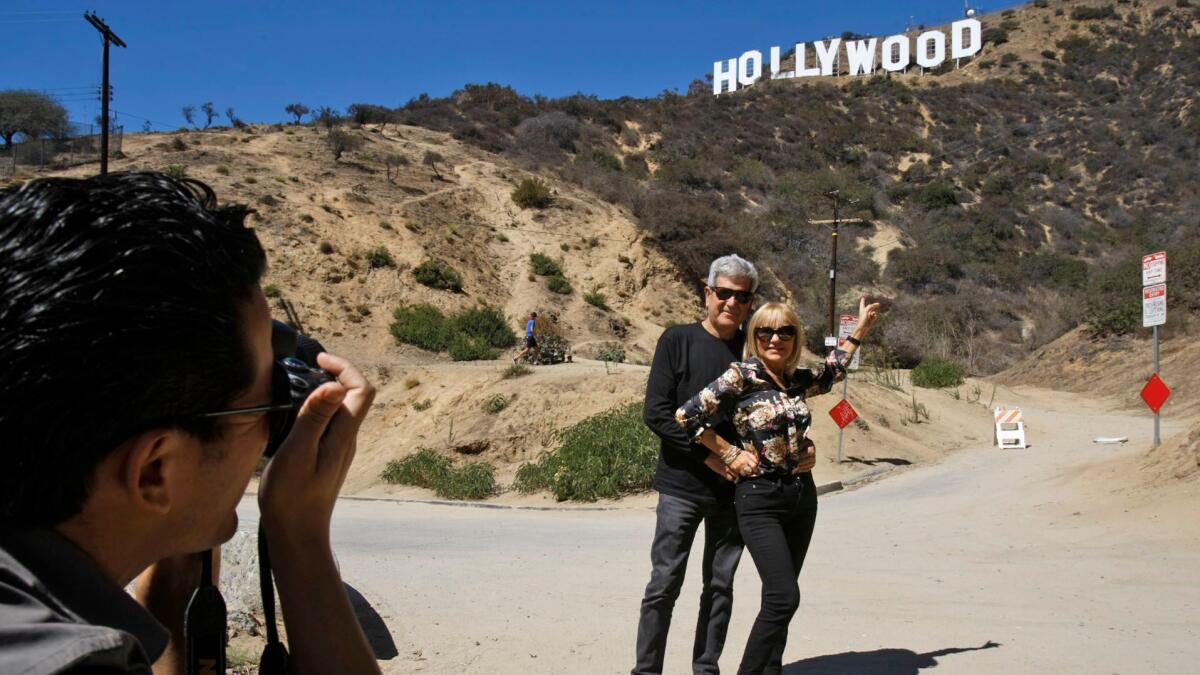Opinion: Is L.A. finally ready for a gondola ride to the Hollywood sign?

- Share via
Mayor Eric Garcetti has revived an idea that once seemed deader than dead: an aerial tramway to the top of Griffith Park.
During an interview with KABC-TV over the weekend, Garcetti tossed out the concept of a gondola, possibly from Universal Studios, to carry visitors to the Hollywood sign. The gondola could ferry people up the mountain to the summit, alleviating some of the traffic and parking problems in the neighborhoods on the southern side of Griffith Park.
“I think we need to have access to the Hollywood sign, both for residents and people who come here,” Garcetti said during the interview. “We’ve got to figure out a better way that doesn’t just choke all of the streets with a thousand tour buses. People can’t get out of their own driveways.”
It’s hard to know if Garcetti was just offering an idea or whether he was floating a trial balloon to see if public opinion has shifted. Past proposals for a gondola or aerial tramway or whatever you want to call it have gone nowhere. A 1968 plan for tramways to Mount Hollywood was derided as “carnival rides to nowhere.” In the 1990s a Hollywoodland resident pitched city officials on a tram from Travel Town to Mount Lee. He was roundly rejected.
Most recently, a proposal for aerial tramways in 2005 was widely and loudly denounced as a terrible idea that would urbanize and commercialize the unspoiled natural beauty of Griffith Park. A draft revision of the park’s master plan suggested two trams, one from the parking lots near the Greek Theatre to the Griffith Observatory and the other from the Autry Museum of the American West to the Toyon Canyon Landfill, a closed garbage dump high in the park that has been turned into a meadow and picnic area.
The idea for the trams, along with proposals for parking garages and a shuttle, was to create more ways for visitors to access the far reaches of the park, deal with the increasing number of cars clogging the roads and generate some revenue for park maintenance. But reaction to the Melendez Plan, named for the firm that prepared the draft, was swift and fierce, and it was quickly scrapped.
But here’s the thing — more crowds and more commercialization came anyway. The neighborhoods on the edge of the park, near Beachwood Canyon, Lake Hollywood and Canyon Drive, get packed with hikers and sightseers trying to reach the Hollywood sign. There are dozens of tour companies sending vans of tourists into the narrow hilly streets on sign-view tours. And it’s not just the Hollywood sign drawing visitors. The roads and parking lots serving the Griffith Observatory are jammed during the summer and holidays.
The city’s recent decision to close the extremely popular trailhead at the top of Beachwood Canyon, and a subsequent lawsuit attempting to force the city to reopen it, has reignited the debate over how to balance access with impact. There’s a perennial fight over whether to keep Griffith Park pristine even if that means it’s harder to reach or whether to develop it and make it more accessible to the masses.
For decades, advocates for the pristine have often succeeded in squashing projects to make the park more accessible. Interestingly, Garcetti’s gondola idea wasn’t immediately denounced by groups that have pooh-poohed past proposals. Perhaps now the idea of a tramway quietly soaring over the hillside neighborhoods carrying carless tourists and hikers into Griffith Park is becoming more appealing.
For more opinions, follow me @kerrycavan
More to Read
A cure for the common opinion
Get thought-provoking perspectives with our weekly newsletter.
You may occasionally receive promotional content from the Los Angeles Times.











